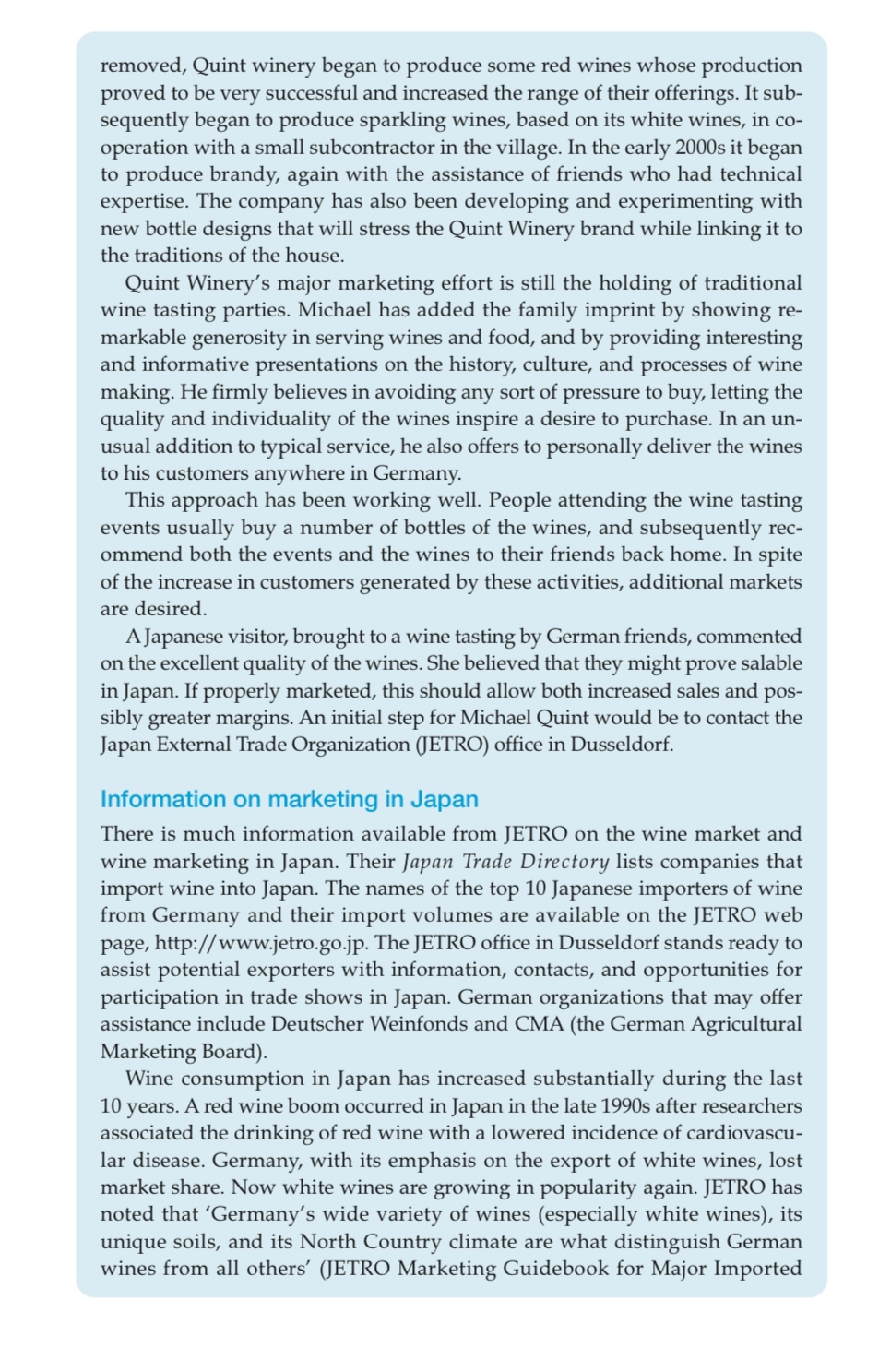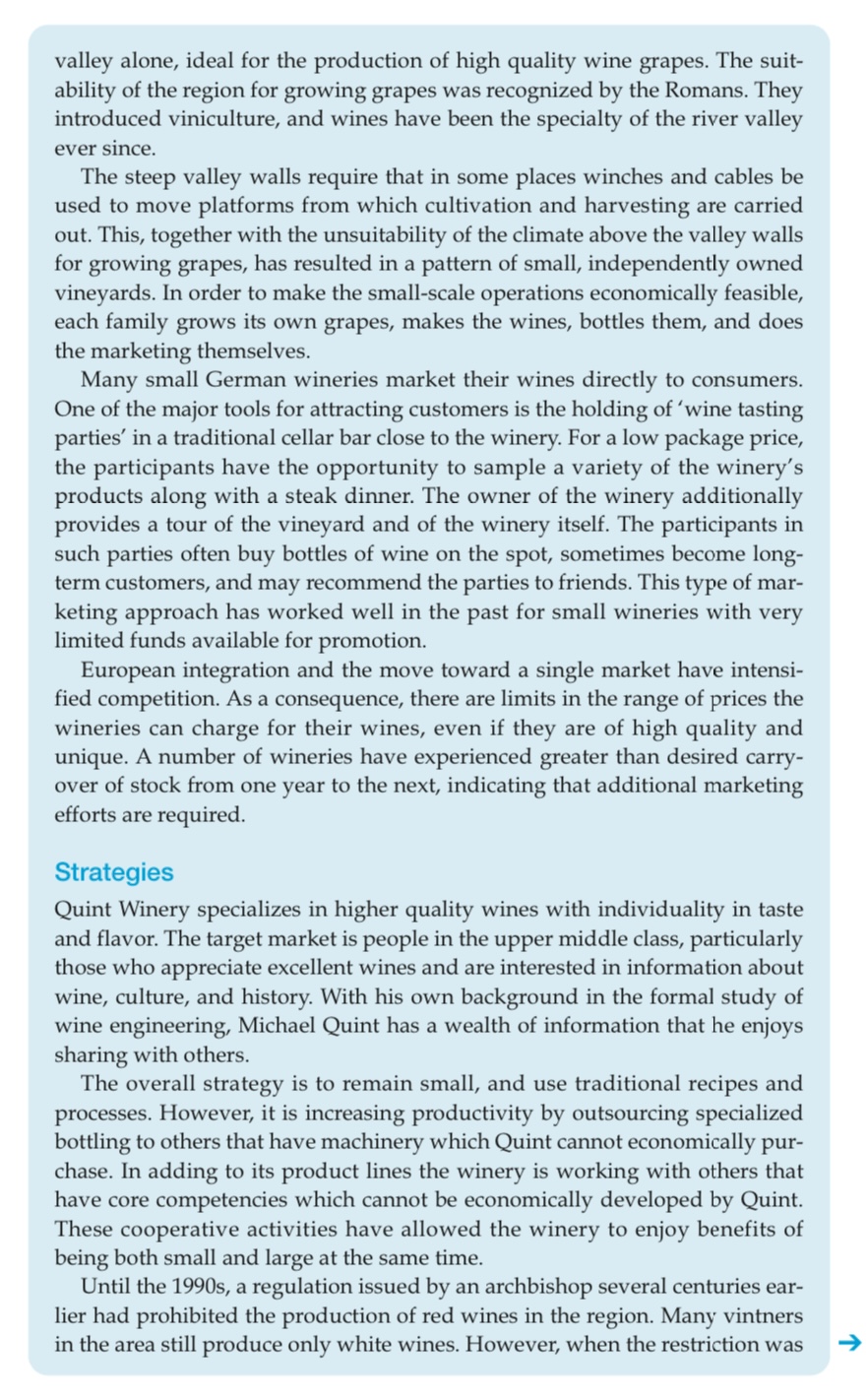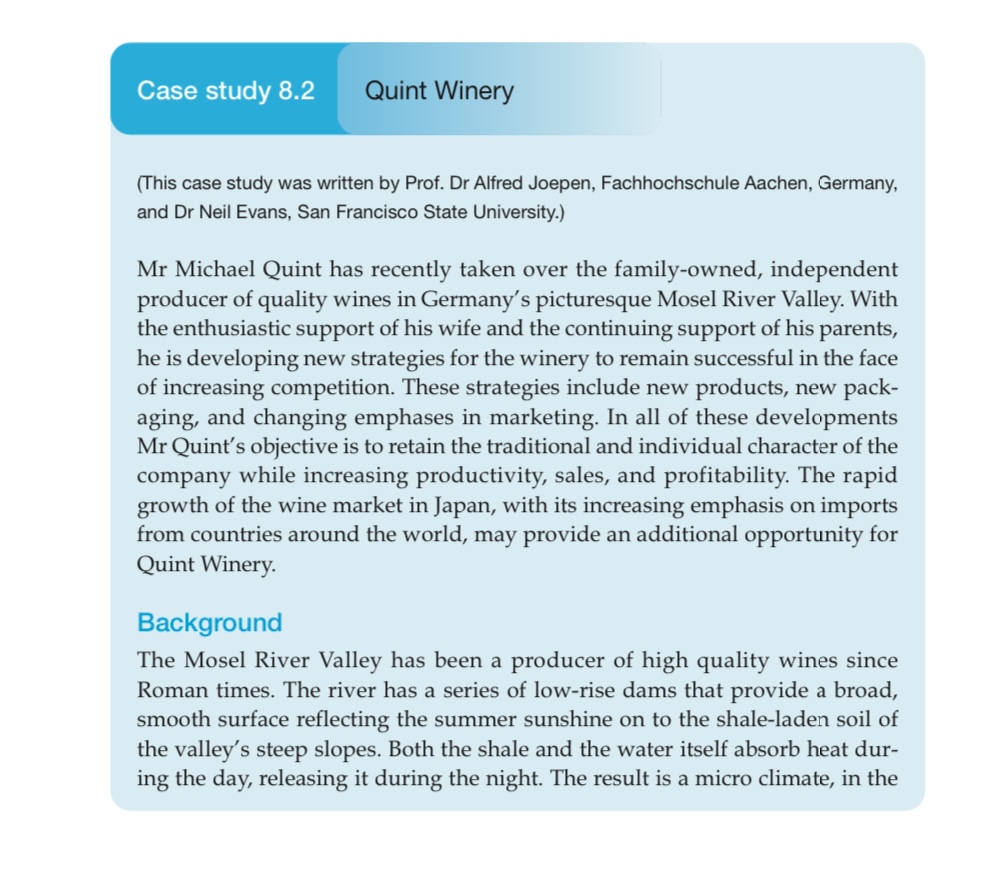Questions:
A. summary of the case
B. most important facts
Fact 1 Fact 2 Fact 3 Etc.
C. the key issue(s) in the case Issue 1 Issue 2 Etc.
D. Specify and evaluate any alternative courses of action
E. Recommend the best course of action
F. 1. Does the Japanese market appear to offer enough potential for Quint Winery to export to Japan? Explain why or why not.
2. How can Quint Winery locate potential Japanese purchasers?
3. Should the winery owner visit Japan, or should he attempt to attract com- pany representatives to come to his winery? Is your answer influenced by specific aspects of Japanese culture? Explain.
4. Should Quint Winery work by itself in any attempts to enter the Japanese market, or should it attempt to work with other local wineries in a type of cooperative effort?
5. What kind of market(ing) research should be done with respect to poten- tial Japanese consumers? expect to encounter? problems may he
6. What other questions should the owner ask? What
Products, available on the JETRO web page, 2004). There is increased compe- tition in the Japanese wine market from South America, Australia, and the United States. However, there is still a good market for high quality white wines from |Germany. There are a number of channels available for selling wine to the Japanese market direct sales to department stores and mass merchandisers, direct sales to wholesalers and discounters, sales to large trading companies, sales through joint venture projects, and sales in bulk or in bottles to domestic liquor producers. A number of small trading companies, specializing in or emphasiz- ing wine, have opened. These small trading companies supply stores or restaurants which do not import directly, or that wish to supplement their own imports with small amounts from other producers. Together, these changes have substantially increased opportunities for small exporters abroad. The market in Japan has become increasingly sophisticated- Larger depart- ment stores carry a wide variety of wines and may hold special promotions and displays. An increasing number of wine specialty stores have been opened- Several Internet wine shops are now serving the Japanese market, offering a very wide range of wines- According to JETRO, price is a key factor in wine purchase decisions, followed by taste, color, and brand. However, consumers have little interest in poorer quality wine. JETRO offers several types of assistance to prospective exporters in foreign countries. It can help in arranging participation in government-sponsored trade shows of consumer goods. These allow potential foreign exporters to in- troduce their products to a wide range of Japanese consumers and compa- nies- JETRO offices abroad provide information on markets and methods of penetration. JETRO Business Support Centers in Japan provide ofce space at no charge for up to two months to foreign business people seeking to export to or invest in Japan. The possibility of marketing to Japan Sales to a small Japanese trading firm or directly to a Japanese chain store might offer two advantages to Quint Wmery. First, it could provide an outlet for current surplus production- Second, away from the intense competition in the domestic market, it might be possible to obtain a higher price for the unique and high quality wines, particularly if there were some way to inform the Japanese public of the history, romance, and culture of the Mosel River Valley vintners. It does not appear that Quint Winery could supply a whole container load of their own wine, nor could a smaller chain purchase a whole container load of one Vintner's wine. What should Michael Quint do next? removed, Quint winery began to produce some red wines whose production proved to be very successful and increased the range of their offerings. It sub- sequently began to produce sparkling wines, based on its white wines, in co- operation with a small subcontractor in the village. In the early 2000s it began to produce brandy, again with the assistance of friends who had technical expertise. The company has also been developing and experimenting with new bottle designs that will siress the Quint Wmery brand while linking it to the traditions of the house. Quint W'mery's major marketing effort is still the holding of traditional wine tasting parties. Michael has added the family imprint by showing re- markable generosity in serving wines and food, and by providing interesting and informative presentations on the history, culture, and processes of wine making. He firmly believes in avoiding any sort of pressure to buy, letting the quality and individuality of the wines inspire a desire to purchase. In an un- usual addition to typical service, he also offers to personally deliver the wines to his customers anywhere in Germany. This approach has been working well. People attending the wine tasting events usually buy a number of bottles of the wines, and subsequently rec- ommend both the events and the wines to their friends back home. In spite of the increase in customers generated by these activities, additional markets are desired. A Japanese visitor, brought to a wine tasting by German friends, commented on the excellent quality of the wines. She believed that they might prove salable in Japan. If properly marketed, this should allow both increased sales and pos- sibly greater margins. An initial step for Michael Quint would be to contact the Japan External Trade Organization (JETRO) office in Dusseldorf. Information on marketing in Japan There is much information available from JETRO on the wine market and wine marketing in Japan. Their Japan Trade Directory lists companies that import wine into Japan. The names of the top 10 Japanese importers of wine from Germany and their import volumes are available on the JETRO web page, http://www.jetro.go.jp. The JETRO office in Dusseldorf stands ready to assist potential exporters with information, contacts, and opportunities for participation in trade shows in Japan. German organizations that may offer assistance include Deutscher Weinfonds and CMA (the German Agricultural Marketing Board). Wine consumption in Japan has increased substantially during the last 10 years. A red wine boom occurred inJapan in the late 19905 after researchers associated the drinking of red wine with a lowered incidence of cardiovascu- lar disease. Germany, with its emphasis on the export of white wines, lost market share. Now white wines are growing in popularity again. JETRO has noted that 'Germany's wide variety of wines (especially white wines), its unique soils, and its North Country climate are what distinguish German wines from all others' (JETRO Marketing Guidebook for Major Imported valley alone, ideal for the production of high quality wine grapes. The suit- ability of the region for growing grapes was recognized by the Romans. They introduced viniculture, and wines have been the specialty of the river valley ever since. The step valley walls require that in some places winches and cables be used to move platforms from which cultivation and harvesting are carried out. This, together with the unsuitability of the climate above the valley walls for growing grapes, has resulted in a pattern of small, independently owned vineyards. In order to make the small-scale operations economically feasible, each family grows its own grapes, makes the wines, bottles them, and does the marketing themselves. Many small German wineries market their wines directly to consumers. One of the major tools for attracting customers is the holding of 'wine tasting parties' in a traditional cellar bar close to the winery. For a low package price, the participants have the opportunity to sample a variety of the winery's products along with a steak dinner. The owner of the winery additionally provides a tour of the vineyard and of the winery itself. The participants in such parties often buy bottles of wine on the spot, sometimes become long- term customers, and may recommend the parties to friends. This type of mar- keting approach has worked well in the past for small wineries with very limited funds available for promotion. European integration and the move toward a single market have intensi- fied competition. As a consequence, there are limits in the range of prices the wineries can charge for their wines, even if they are of high quality and unique. A number of wineries have experienced greater than desired carry- over of stock from one year to the next, indicating that additional marketing efforts are required. Strategies Quint Winery specializes in higher quality wines with individuality in taste and avor. The target market is people in the upper middle class, particularly those who appreciate excellent wines and are interested in information about wine, culture, and history. With his own background in the formal study of wine engineering, Michael Quint has a wealth of information that he enjoys sharing with others. The overall strategy is to remain small, and use traditional recipes and processes. However, it is increasing productivity by outsourcing specialized bottling to others that have machinery which Quint cannot economically pur- chase. In adding to its product lines the winery is working with others that have core competencies which cannot be economically developed by Quint. These cooperative activities have allowed the winery to enjoy benefits of being both small and large at the same time. Until the 19905, a regulation issued by an archbishop several centuries ear- lier had prohibited the production of red wines in the region. Many vintners in the area still produce only white wines. However, when the restriction was -) Case study 8.2 {This case study was written by Prof. DrAltred deepen. Faohhooheohute Aachen. Germany. and Dr Neil Evans. San Francisco State University.) Mr Michael Quint has recently taken over the family-owned, independent producer of quality wines in Germany' 5 picturesque Mosel River Valley. With the enthusiastic support of his wife and the continuing support of his parents, he is developing new strategies for the winery to remain successful in the face of increasing competition. These strategies include new products, new pack- aging, and changing emphases in marketing. In all of these developments Mr Qujnt's objective is to retain the traditional and individual character of the company while increasing productivity, sales, and profitability. The rapid growth of the wine market in japan, with its increasing emphasis on imports from countries around the world, may provide an additional opportunity for Quint Winery. Background The Mosel River Valley has been a producer of high quality wines since Roman times. The river has a series of low-rise dams that provide a broad, smooth surface reflecting the summer sunshine on to the shale-laden soil of the valley' s steep slopes. Both the shale and the water itself absorb heat dur- ing the day, releasing it during the night. The result is a micro climate, in the










